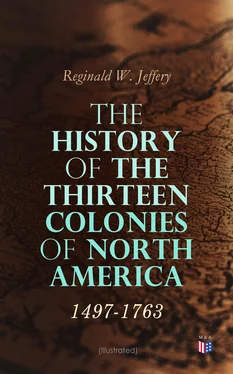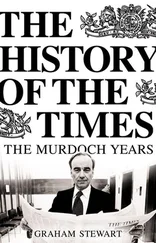In 1585 Raleigh sent seven ships and one hundred and eight settlers to the land which had been granted to him by patent. The territory had already been named Virginia, in honour of the Queen, and it was here that he hoped to establish a little colony composed of sturdy Englishmen. In June the settlers, having landed in Roanoke, were left under the leadership of Ralph Lane; the other generals, Grenville, Cavendish, and Amidas, returning to the mother country. From the outset it was certain that Raleigh's colony must fail. The man chosen as leader had no special aptitude for the post, being possessed with the mania for discovery rather than the desire to teach the settlers to form a self-supporting community. But even worse than this, Lane made the fatal error of estranging the natives by the severity and brutality of his punishments. Exactly a year after the settlers had landed, Sir Francis Drake put in to see how his friend Raleigh's Utopian schemes progressed. He found the colony in a miserable plight and, yielding to the earnest entreaties of the settlers, took them on board and sailed to England. Raleigh, however, had not forgotten his colony, and had dispatched Sir Richard Grenville with supplies; but when he reached the settlement he found it deserted. Sir Walter Raleigh's buoyant nature was not depressed by this first failure, and in 1587 a fresh attempt to settle Virginia was made. Under the command of White, one hundred and thirty-three men and seventeen women were sent out. White soon returned to England for supplies, leaving his daughter Eleanor Dare, who gave birth to the first white child born in the New World. The unhappy emigrants received but little assistance from the home authorities. Certainly two expeditions were sent out to help them, but they failed because their captains found it more lucrative and exciting to go privateering. The stirring times in Europe and the coming of the Armada were sufficient to absorb the minds of such men as Raleigh and Drake, and the colony in Virginia was left to its fate. What that fate was can only be imagined, for, when White at last reached Virginia in 1589, not a trace of the colony was to be found, while another expedition in 1602 proved equally unsuccessful in the search. Hunger and the Indians had done their cruel work, and the hand of destiny seemed turned against the foundation of an Anglo-Saxon colony in the mysterious West.
There were, however, dominant motives for colonisation at the beginning of the seventeenth century, and these, together with the intrepidity of certain of the Elizabethan school, changed the aspect of the whole question. The previous incentives for discovery and adventure upon the high seas had been the tricks of imagination, the more glorious scheme of spreading Christianity and the race for gold. But now there was a fear amongst the more intellectual thinkers in England that the country was suffering from a surplus population. This purely imaginary danger gave birth to the idea that America might provide new homes for this surplus, and, at the same time, bring new markets into existence which in the future would very materially help to develop the naval resources of the English.
One of the most able and energetic of the new patrons of colonisation was Shakespere's friend, the Earl of Southampton, who in March 1602 dispatched to the West, Bartholomew Gosnold with thirty-two companions. This little band of adventurers landed further north than Raleigh's ill-fated colonists, probably at a spot where in later years the Puritan settlers established themselves. The chief feature of Gosnold's venture was the discovery of a new route to the West by way of the Azores, and thus a week was saved in future voyages. In the following year the Discovery and Speedwell were sent out under Martin Pring, the patrons of the expedition having first obtained formal permission from Sir Walter Raleigh, whose patent rights were still regarded as valid. It is interesting to notice that with this concession on Raleigh's part his connection with Virginia ceased for ever.
One of Pring's patrons was Richard Hakluyt, to whom all Englishmen are indebted for his great prose epic and for the stimulus he gave to the early founders of the British Empire. Hakluyt was born in London about the year 1552. He was educated at Westminster School and Christ Church, Oxford, where he took his degree in 1574. His interest in geography and discovery had been aroused when quite a boy by seeing a map in the possession of a relative, and from that moment, he writes, "I constantly resolved, if ever I was preferred to the University, where better time and more convenient place might be ministred for those studies, I would, by God's assistance, prosecute that knowledge and kinde of literature, the doores whereof (after a sort) were so happily opened before me." 33Hakluyt's first book was published in 1582, under the title, Divers Voyages touching the discoverie of America and the Ilands adjacent unto the same, made first of all by Englishmen and afterwards by the Frenchmen and Britons . This work consisted of a collection of documents to support England's claim to the prior discovery of America. In the autumn of 1584 he presented to Queen Elizabeth his Discourse of Western Planting , the writing of which was largely due to the inspiration of Sir Walter Raleigh. The subject matter had been supplied by the two voyagers to Virginia, Captains Amidas and Barlow. The first edition of his great work saw light in the year after the Armada; but Hakluyt was not satisfied, and for nine more years laboured on, until in 1598 he produced the second edition in three volumes, and the world was infinitely the richer for the Principal Navigations, Voyages, Traffiques, and Discoveries of the English Nation .
The year that Hakluyt sent out Pring to make discoveries is ever famous for the death of Queen Elizabeth. The great queen, whatever her faults may have been, had indeed bound her subjects to her by affection and admiration, and created amongst them a remarkable spirit of both patriotism and gallantry. It was therefore a fitting and happy circumstance that associated the last of the Tudors with the first of our American colonies. Virginia, named from Elizabeth, the child, so to speak, of a queen, came in time to be the mother of Presidents. It is not, however, until the accession of the pedantic James that a stern resolve to accomplish the establishment of a colony seems to have been taken. The irony of history is better illustrated in this fact than perhaps elsewhere. The mean mind and timid heart of James I. could never arouse or inspire enthusiasm as Elizabeth's actions had done. And yet the appreciation of the importance of a great Empire was reserved for the reign of the first Stuart rather than during the rule of the greatest of the Tudors.
The pressing question of surplus population which had reached a climax at the accession of James I., together with the prosperity and success of the newly formed East India Company may have had something to do with the momentous decision that was taken in 1606. In that year two companies were formed: the first was the London Company, which was given permission by the Crown to plant in North America between 45° and 38° north latitude; the second division was the Plymouth Company, whose rights of plantation overlapped those of the London Company, their district being between 41° and 34° north latitude. With the history of this second company we shall deal later.
The London Company consisted of various members, such as Richard Hakluyt, the recorder of voyages; Sir George Somers, "a lamb on shore, a lion at sea"; 34and Sir Thomas Gates. The Council was nominated by the King, and included many well-known men of the day; in particular, Sir Ferdinando Gorges, who played an important part in colonial history for many years, 35and Sir Edwin Sandys, who, in the perilous time which came upon the Company, fought manfully for the right. The system of administration was of considerable complexity, as the control of affairs was both divided and qualified. In return for finding the capital for the proper working of the scheme, the Company was to receive certain trading privileges. The actual government was vested in two councils, both of which were nominated by James I., the one to be resident in England and supreme in all political and legislative affairs, the other to be established in the colony and liable for the proper administration of all local matters. The orders given to those in office, when the first settlement was made, were to a certain extent harsh, but in no way contrary to the spirit of the times. The Church of England was to be supported and the supremacy of the King to be acknowledged. All serious crimes were to be tried by jury and punished with death, but the penalty for minor offences was left to the discretion of the resident council. The Company took care that no trade was carried on by private individuals, and it was insisted that magazines should be erected for the produce of the colony and for supplying necessities to the colonists. It may be stated finally that the old ideas of enterprise and adventure were not lost sight of, and what had stirred Columbus and many another voyager was now definitely mentioned in the commands. The settlers were told "to show kindness to the savages and heathen people in those parts, and use all proper means to draw them to the true knowledge and service of God." 36
Читать дальше












